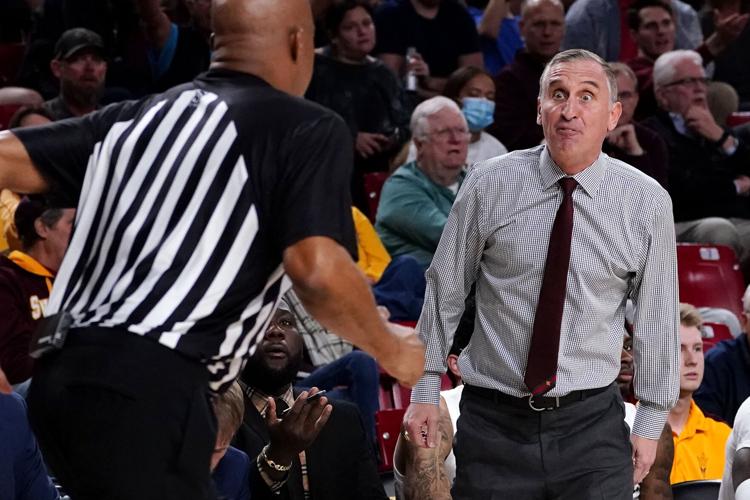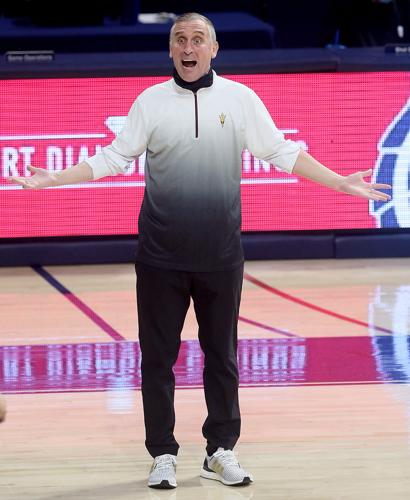One of my first reporting assignments in this business was to cover a South High School basketball game in Salt Lake City, mid-1970s. To my astonishment, I walked into the Cubs’ old gymnasium and saw coach George Souvall sitting on the bench, anchored by a large seat belt.
Really — a seat belt taken from a car.
I had heard a lot about “Seat Belt Souvall,” but I thought it was an exaggeration. It wasn’t. The long-time basketball coach was so volatile, so quick to temper, accumulating so many technical fouls, that he treated his the-refs-are-out-to-get-me mentality with the simplest option: a seat belt.
By halftime, Souvall abandoned the seat belt and was stomping up a storm on the sideline.
Those memories came barreling back on Jan. 3, 2016, when first-year ASU basketball coach Bobby Hurley created such a fuss that he was assessed two technical fouls and ejected from his first UA-ASU game.
I couldn’t — I can’t — remember a more agitated, me-vs.-the-refs persona in the Pac-12 than Hurley. Cal’s Lou Campanelli, UCLA’s Walt Hazzard and Arizona’s Sean Miller were extremists. But Hurley is unchallenged as the Pac-12’s most-likely-to-lose-it basketball coach of the last 40 years.
To be fair, the Hurley of 2016 isn’t the Hurley of 2022. He is still the league’s most animated coach, the coach who gets the most TV time during times of crisis, but he is more controlled. Part of it came via a directive from ASU president Michael Crow, who instructed Hurley to act more professionally.
How’s it going? Hurley was paid a $1 million retention bonus on Jan. 1. But on Sunday, he was fined $20,000 by the Pac-12 for “inappropriate behavior” in a loss at Stanford. Ordinarily, that would be a banner headline, but Hurley’s tantrums have worn thin.
His behavior is no longer the lead story; his future at ASU is. As Arizona prepares to host the Sun Devils on Saturday, I fear that we have seen the best of ASU basketball that we’re going to see heading forward.
Hurley failed to take advantage of implosions/coaching changes at UCLA and Arizona and has been unable to take the Sun Devils to higher ground. ASU has won a single NCAA Tournament game in his six seasons, and that was in a play-in game as an 11th seed.
Through 6½ seasons, Hurley’s Sun Devils are 110-94. His predecessor, the unassuming Herb Sendek, was 120-109 in his first seven seasons. Same results, different strokes.
A year ago, Utah fired Larry Krystkowiak, who went 138-97 over his first seven years. But Krystkowiak didn’t have Hurley’s name, and expectations at Utah are significantly higher than those at ASU.
To me, this is a sadly missed opportunity both by ASU and the Pac-12, which since 1978 has lacked the type of rivalries seen in the Big Ten and ACC. Except for Arizona-UCLA, there has been no lasting, can’t-miss type showdown that comes anywhere close to Bruins vs. Wildcats.
For 10 or 12 years, Arizona-Stanford was the equal to any rivalry anywhere, even Duke-North Carolina. But Stanford hasn’t been a factor since Mike Montgomery left 17 years ago, and Maples Pavilion no longer has a buzz.
What about Arizona-Oregon? The Ducks are a certified Top-25 program, but basketball is a secondary sport on the UO campus and there’s little or no magic in Matthew Knight Arena the way there has been periodic bedlam in UA-Washington showdowns in Seattle or Arizona-Colorado battles in Boulder.
When Hurley was hired away from Buffalo, I all but bought pom-poms to herald his arrival in the Pac-12. What the league needed more than anything was Hurley to take advantage of the slippage at UCLA and Arizona and become part of a Big Three.
Instead, Hurley’s Sun Devils have yet to finish a season in the AP Top 25.
One of the overriding issues is that the ASU administration has not moved to improve the school’s basketball plant. It is building a $100 million hockey and multi-purpose arena across the street from the uninspiring Desert Financial Arena, which probably ranks No. 11 among Pac-12 basketball facilities, a spot ahead of OSU’s 72-year-old Gill Coliseum.
Arizona has spent about $100 million to re-do the core of McKale Center in recent years. Utah has spent so much updating the Huntsman Center that it almost seems new — and it opened in 1969. UCLA’s Pauley Pavilion, which opened in 1966, completed a $140 million makeover a few years ago.
While ASU sleeps, its conference opponents have spent tens of millions of dollars to upgrade basketball facilities.

Arizona State coach Bobby Hurley calls out to referee in the first half during last January’s game in McKale Center. The Wildcats won 80-67, completing a season sweep.
Stanford, Washington and Cal essentially rebuilt their old bandboxes the last 15 years, USC finally got out of the gloomy Los Angeles Sports Arena when it spent $150 million on the Galen Center. Now the Trojans are relevant.
The ASU basketball arena opened in 1974, and it’s such a relic that you almost expect to see Ned Wulk sitting on the bench, coaching Byron Scott and Fat Lever. It is today’s equivalent of USC’s old Sports Arena.
Try to recruit to that. It’s as if ASU gave Hurley a horse and a helmet but no sword.
I remain hopeful that Hurley will beat the odds, land a game-changing recruiting class or two and become the next out-of-the-woodwork power to rival the recent emergence of Auburn and Baylor.
But it’s more likely that window has closed.






